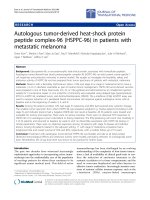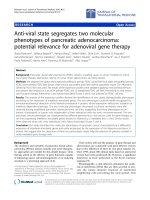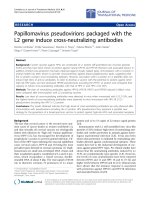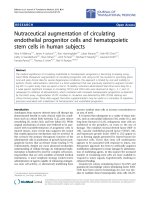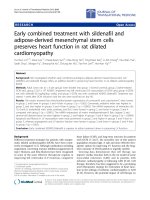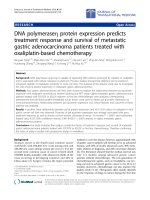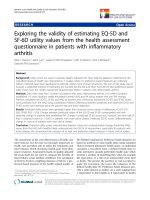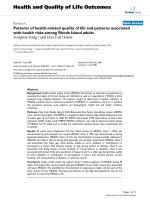Báo cáo hóa học: " Overcoming viral escape with vaccines that generate and display antigen diversity in vivo" doc
Bạn đang xem bản rút gọn của tài liệu. Xem và tải ngay bản đầy đủ của tài liệu tại đây (221.23 KB, 4 trang )
BioMed Central
Page 1 of 4
(page number not for citation purposes)
Virology Journal
Open Access
Hypothesis
Overcoming viral escape with vaccines that generate and display
antigen diversity in vivo
Albert García-Quintanilla
Address: Atanasio Barrón 14, P4-5A, 41003 Sevilla, Spain
Email: Albert García-Quintanilla -
Abstract
Background: Viral diversity is a key problem for the design of effective and universal vaccines.
Virtually, a vaccine candidate including most of the diversity for a given epitope would force the
virus to create escape mutants above the viability threshold or with a high fitness cost.
Presentation of the hypothesis: Therefore, I hypothesize that priming the immune system with
polyvalent vaccines where each single vehicle generates and displays multiple antigen variants in vivo,
will elicit a broad and long-lasting immune response able to avoid viral escape.
Testing the hypothesis: To this purpose, I propose the use of yeasts that carry virus-like
particles designed to pack the antigen-coding RNA inside and replicate it via RNA-dependent RNA
polymerase. This would produce diversity in vivo limited to the target of interest and without killing
the vaccine vehicle.
Implications of the hypothesis: This approach is in contrast with peptide cocktails synthesized
in vitro and polyvalent strategies where every cell or vector displays a single or definite number of
mutants; but similarly to all them, it should be able to overcome original antigenic sin, avoid major
histocompatibility complex restriction, and elicit broad cross-reactive immune responses. Here I
discuss additional advantages such as minimal global antagonism or those derived from using a yeast
vehicle, and potential drawbacks like autoimmunity. Diversity generated by this method could be
monitored both genotypically and phenotypically, and therefore selected or discarded before use
if needed.
Background
Viral reverse transcriptases and RNA-dependent RNA
polymerases (RDRP) show the highest mutation rates
found in nature. Diversity generated allows these viruses
to evade host defenses and poses a key problem in vaccine
design. Infected individuals develop a titanic fight to
avoid viral escape. However, above certain diversity
threshold the immune system is unable to control the
virus and collapses [1,2]. Likewise, inverse relationship
between vaccine efficacy and virus divergence has been
demonstrated [3] and may explain why no vaccine exists
against the highly variable HIV or hepatitis C virus, in con-
trast to other viruses such as influenza virus (where for-
mulations need to be updated yearly to include
predominant circulating strains) or hepatitis B virus
(where immunologically targeted regions remain con-
served due to the viral fitness cost and the vaccine is feasi-
ble and broadly effective).
Published: 22 November 2007
Virology Journal 2007, 4:125 doi:10.1186/1743-422X-4-125
Received: 4 October 2007
Accepted: 22 November 2007
This article is available from: />© 2007 García-Quintanilla; licensee BioMed Central Ltd.
This is an Open Access article distributed under the terms of the Creative Commons Attribution License ( />),
which permits unrestricted use, distribution, and reproduction in any medium, provided the original work is properly cited.
Virology Journal 2007, 4:125 />Page 2 of 4
(page number not for citation purposes)
Current vaccine strategies to overcome diversity include
the use of (I) conserved or consensus epitopes [4,5], (II)
chimeric antigens containing fragments from diverse pop-
ulations [6-8], and (III) the inclusion of multiple strain
variants of the same antigen [9]. Here I propose a new
kind of vaccines that generate diversity in vivo.
Presentation of the hypothesis
I hypothesize that priming the immune system with poly-
valent vaccine candidates where each single vehicle gener-
ates and displays multiple antigen variants in vivo, is safe
and will elicit a broad and long-lasting immune response
able to avoid viral escape. This strategy is different from
peptide cocktails synthesized in vitro and polyvalent strat-
egies where every cell or vector displays a single or definite
number of mutants.
Testing the hypothesis
In order to generate such diversity in vivo I propose the use
of recombinant yeasts that carry virus-like particles (VLPs)
designed to pack the antigen-coding RNA inside and rep-
licate it via RDRP. The VLPs can be coded in cis and pack
their own RNA with or without heterologous sequences
inserted, or be supplied in trans by a vector and pack a het-
erologous RNA that bears the appropriate cis packing and
replication motifs. A particular example of this last would
be the use of S. cerevisiae carrying L-A totivirus VLPs that
pack and replicate the RNA coding for an HIV epitope.
Diversity will take place only within the RNA of interest
every time the RDRP replicates it, while keeping the
genome unchanged. Degree of variation will be a function
of the RDRP mutation rate, number of cycles (time), target
length and average of VLPs per cell. For a conservative rep-
lication mechanism, every daughter cell will accumulate
most of its diversity history. These mutations will occur
randomly whenever not toxic or essential for the cell or
VLPs, and will be kept under biological parameters. How-
ever, only sequences that share enough homology to be
packed and replicated will be transmitted. The yeast cell
wall will avoid cellular lysis, and VLPs will spread by cyto-
duction, without killing the yeast. The target RNAs will be
translated by the cellular machinery and their products
displayed on the cellular surface [10], secreted outside or
kept inside the cells. Multiple yeasts may be designed
using consensus, conserved, variable or mosaic target RNA
sequences as starting points.
Implications of the hypothesis
This strategy is supported by a mathematical model [11]
that predicts that a vaccine will fail if it does not protect
against a sufficiently large fraction of HIV strains, no mat-
ter how immunogenic it is. In agreement with this, other
teams have proposed to include most of the diversity for
a given epitope based on peptide combinations synthe-
sized in vitro [12-14]. However, these candidates require
adjuvants to elicit an immune response and their synthe-
sis is complex. Similarly, polymorphic proteins or DNA
vaccines generated in vivo were suggested before [15] but
up to date nobody had solved how to create diversity
without killing the host neither mutating its genome.
Thus, infection of cell cultures or animals used for attenu-
ated or inactivated vaccines generate limited variation and
kill the host, while in vivo evolution strains like E. coli XL-
1 Red (Stratagene) or protocols with mutagens and retro-
transposons mutate the host genome.
Polyvalent vaccines containing multiple variants of an
epitope (I) elicit broader cross-reactive immune responses
than candidates with fewer variants [9,16], (II) overcome
original antigenic sin that may result from sequential
exposure to antigen variants [16], (III) avoid lack of cellu-
lar response to certain epitopes due to major histocom-
patibility complex (MHC) restriction [17] and, (IV) may
suppress T-cell antagonism when peptides are related
[18]. Similar results would be expected also for antigenic
diversity generated in vivo.
Some authors have suggested that simultaneous adminis-
tration of antigen variants could be subject to T-cell antag-
onism [19]. However, only some amino acid
substitutions are antagonist and occur mainly within the
positions that bind the T-cell receptor, while the others are
neutral or agonist [20]. These authors [19] also indicate
that the stronger the response to a particular epitope, the
smaller the relative effect of antagonism. Therefore, this
interference should be less in immunodominant
epitopes. A polyvalent vaccine that broadens the immune
response against all epitope variants will minimize global
antagonism and will avoid viral escape, even if some
altered peptide ligands reduce immunodominance of the
original epitope by lowering the peptide-MHC complex
stability.
Another potential concern of this approach is that T cells
require around 100–200 identical MHC-peptide com-
plexes on the target cell to be activated. This implies that
each new variant needs to reach a minimum number or
percentage to raise a response against it. This should not
be a problem since every RNA is translated several times.
Also, once a mutation arises, the probability of a new
change within the radius of MHC-displayed peptides con-
taining such mutation is very low, thus ensuring enough
copies of the variant occurred. Hence, even if two RNAs
with mutations alongside are different they may share sev-
eral identical T-cell epitopes.
Similarly, each particular mutant could be too rare to
stimulate a broad humoral immunity. The first interaction
between a B cell and a pathogen is usually multivalent,
Virology Journal 2007, 4:125 />Page 3 of 4
(page number not for citation purposes)
with many weak interactions between multiple B-cell
receptors and pathogen proteins "adding up". But if a par-
ticular B cell can only bind (weakly) to a few copies of
antigen on a yeast cell, that B cell might never become
activated. However, this situation may end up being good
because only the B cells that can recognize many antigen
mutants would expand clonally. This potential advantage
may be lost in current polyvalent vaccines where
"enough" amount of every variant is displayed, thus
favouring broad antibody responses instead of broadly
neutralizing antibodies.
There is a common thinking that vaccines containing high
number of variants would include also antigens that show
molecular mimicry to self-antigens and therefore could
cause autoimmunity. Despite examples of autoimmune
diseases caused by infections exist, recent studies show
that molecular mimicry has been overvalued and that by
itself is not enough to break immune tolerance, illustrat-
ing that these events are dose-dependent and require
other mechanisms, like bystander activation and anti-
genic persistence [21,22], or a previous underlying proc-
ess in susceptible individuals [23]. Under normal
conditions the immune system prevents the formation of
self-reactive antibodies, and when they arise they are usu-
ally transient. In fact, some of the broadly neutralizing
antibodies against HIV are polyspecific antibodies that
react with self-tissues [24]. Paradoxically, two drugs
(Copaxone and Peptimmune-2301) based on the use of
random sequence peptide mixtures reduce the frequency
of autoimmune multiple sclerosis relapses. In the worst
possible scenario, susceptible individuals could be tested
individually before applying or discarding vaccination. If
the risk to trigger autoimmunity becomes unacceptable
for prophylactic use, it still would be a therapeutic alterna-
tive for diseases without a cure. This is the case for cancer
treatments under clinical trials using antibodies against
self-antigens [25].
The final drawback is relative to current manufacturing
and quality regulations that require every lot to be fully
characterized and reproducible in order to be marketable.
This is intrinsically difficult for random diversity, but new
emerging technologies like microarrays are now available
and let genotype characterization of thousands of
sequences in a single experiment, while other well-known
protocols, such as FACS, allow phenotype selection or dis-
posal of specific proteins and cells, thus guarantying the
maximum presence of desired variants, and the exclusion
of unwanted ones that could bind to autoimmune serum.
In the best setting, an extraordinary product with excep-
tional results may force current policies to change in order
to outweigh all other considerations. In the opposite situ-
ation, it would serve as proof of concept.
Finally, the yeast vehicles allow post-translational proc-
esses that bacterial vectors cannot, economical produc-
tion, multiple doses, and dried formulations to omit the
cold chain. They also exert a strong adjuvant effect [26]
and can be administered orally to target the gut-associated
lymphoid tissue [27] (which comprises over 70% of the
immune cells and represents the main reservoir and repli-
cation site for HIV and other viruses). In addition, the sys-
tem proposed includes the use of VLPs, which provide an
efficient strategy to raise immune responses toward
desired epitopes [28].
Competing interests
AGQ has applied for a patent covering the methods
described here to generate and display antigenic diversity
in vivo.
References
1. Nowak MA, Anderson RM, McLean AR, Wolfs TF, Goudsmit J, May
RM: Antigenic diversity threshold and the development of
AIDS. Science 1991, 254:963-969.
2. Farci P, Shimoda A, Coiana A, Diaz G, Melpolder JC, Strazzera A,
Chien DY, Munoz SJ, Balestrieri A, Purcell RH, Alter HJ: The out-
come of acute hepatitis C predicted by the evolution of the
viral quasispecies. Science 2000, 288:339-344.
3. Craigo JK, Zhang B, Barnes S, Tagmyer TL, Cook SJ, Issel CJ, Monte-
laro RC: Envelope variation as a primary determinant of len-
tiviral vaccine efficacy. Proc Natl Acad Sci USA 2007,
104:15105-15110.
4. De Groot AS, Marcon L, Bishop EA, Rivera D, Kutzler M, Weiner DB,
Martin W: HIV vaccine development by computer assisted
design: the GAIA vaccine. Vaccine 2005, 23:2136-2148.
5. Gao F, Korber BT, Weaver E, Liao HX, Hahn BH, Haynes BF: Cen-
tralized immunogens as a vaccine strategy to overcome
HIV-1 diversity. Expert Rev Vaccines 2004, 3:S161-S168.
6. Fischer W, Perkins S, Theiler J, Bhattacharya T, Yusim K, Funkhouser
R, Kuiken C, Haynes B, Letvin NL, Walker BD, Hahn BH, Korber BT:
Polyvalent vaccines for optimal coverage of potential T-cell
epitopes in global HIV-1 variants. Nat Med 2007, 13:100-106.
7. Thomson SA, Jaramillo AB, Shoobridge M, Dunstan KJ, Everett B,
Ranasinghe C, Kent SJ, Gao K, Medveckzy J, Ffrench RA, Ramshaw IA:
Development of a synthetic consensus sequence scrambled
antigen HIV-1 vaccine designed for global use. Vaccine 2005,
23:4647-4657.
8. Locher CP, Heinrichs V, Apt D, Whalen RG: Overcoming anti-
genic diversity and improving vaccines using DNA shuffling
and screening technologies. Expert Opin Biol Ther 2004,
4:589-597.
9. Slobod KS, Bonsignori M, Brown SA, Zhan X, Stambas J, Hurwitz JL:
HIV vaccines: brief review and discussion of future direc-
tions. Expert Rev Vaccines 2005, 4:305-313.
10. Boder ET, Wittrup KD: Yeast surface display for directed evo-
lution of protein expresion, affinity, and stability. Methods
Enzymol 2000,
328:430-444.
11. Nowak MA, McLean AR: A mathematical model of vaccination
against HIV to prevent the development of AIDS. Proc Biol Sci
1991, 246:141-146.
12. Estaquier J, Gras-Masse H, Boutillon C, Ameisen JC, Capron A, Tartar
A, Auriault C: The mixotope: a combinatorial peptide library
as a T cell and B cell immunogen. Eur J Immunol 1994,
24:2789-2795.
13. Meyer D, Anderson DE, Gardner MB, Torres JV: Hypervariable
epitope constructs representing variability in envelope glyc-
oprotein of SIV induce a broad humoral immune response in
rabbits and rhesus macaques. AIDS Res Hum Retroviruses 1998,
14:751-760.
14. Hewer R, Meyer D: Peptide immunogens designed to enhance
immune responses against human immunodeficiency virus
(HIV) mutant strains: a plausible means of preventing viral
persistence. J Theor Biol 2005, 233:85-90.
Publish with BioMed Central and every
scientist can read your work free of charge
"BioMed Central will be the most significant development for
disseminating the results of biomedical research in our lifetime."
Sir Paul Nurse, Cancer Research UK
Your research papers will be:
available free of charge to the entire biomedical community
peer reviewed and published immediately upon acceptance
cited in PubMed and archived on PubMed Central
yours — you keep the copyright
Submit your manuscript here:
/>BioMedcentral
Virology Journal 2007, 4:125 />Page 4 of 4
(page number not for citation purposes)
15. Cohen JI: A new approach to vaccination: polymorphic vac-
cines for RNA viruses. Med Hypotheses 2000, 55:353-355.
16. Anderson DE, Carlos MP, Nguyen L, Torres JV: Overcoming orig-
inal (antigenic) sin. Clin Immunol 2001, 101:152-157.
17. Meyer D, Torres JV: Hypervariable epitope construct: a syn-
thetic immunogen that overcomes MHC restriction of anti-
gen presentation. Mol Immunol 1999, 36:631-637.
18. Singh RA, Rodgers JR, Barry MA: The role of T cell antagonism
and original antigenic sin in genetic immunization. J Immunol
2002, 169:6779-6786.
19. Larke N, Im EJ, Wagner R, Williamson AL, McMichael AJ, Hanke T:
Combined single-clade candidate HIV-1 vaccines induce T
cell responses limited by multiple forms of in vivo immune
interference. Eur J Immunol 2007, 37:566-577.
20. Nishimura Y, Chen YZ, Kanai T, Yokomizo H, Matsuoka T, Matsush-
ita S: Modification of human T-cell responses by altered pep-
tide ligands: a new approach to antigen-specific
modification. Intern Med 1998, 37:804-817.
21. Benoist C, Mathis D: Autoimmunity provoked by infection:
how good is the case for T cell epitope mimicry? Nat Immunol
2001, 2:797-801.
22. Kim B, Kaistha SD, Rouse BT: Viruses and autoimmunity. Autoim-
munity 2006, 39:71-77.
23. Christen U, von Herrath MG: Induction, acceleration or preven-
tion of autoimmunity by molecular mimicry. Mol Immunol
2004, 40:1113-1120.
24. Haynes BF, Fleming J, St Clair EW, Katinger H, Stiegler G, Kunert R,
Robinson J, Scearce Rm, Staats HF, Ortel TL, Liao HX, Alam SM: Car-
diolipin polyspecific autoreactivity in two broadly neutraliz-
ing HIV-1 antibodies. Science 2005, 308:1906-1908.
25. Ribas A, Camacho LH, Lopez-Berenstein G, Pavlov D, Bulanhagui CA,
Millham R, Comin-Anduix B, Reuben JM, Seja E, Parker CA, Sharme
A, Glaspy JA, Gomez-Navarro J: Antitumor activity in melanoma
and anti-self responses in a phase I trial with the anti-cito-
toxic T lymphocyte-associated antigen 4 monoclonal anti-
body CP-675,206. J Clin Oncol 2005, 23:8968-8977.
26. Stubbs AC, Martin KS, Coeshott C, Skaates SV, Kuritzkes DR, Bell-
grau D, Franzusoff A, Duke RC, Wilson CC: Whole recombinant
yeast vaccine activates dendritic cells and elicits protective
cell-mediated immunity. Nat Med 2001, 7:625-629.
27. Beier R, Gebert A: Kinetics of particle uptake in the domes of
Peyer's patches. Am J Physiol 1998, 275:G130-G137.
28. Ramqvist T, Andreasson K, Dalianis T: Vaccination, immune and
gene therapy based on virus-like particles against viral infec-
tions and cancer. Expert Opin Biol Ther 2007, 7:997-1007.

